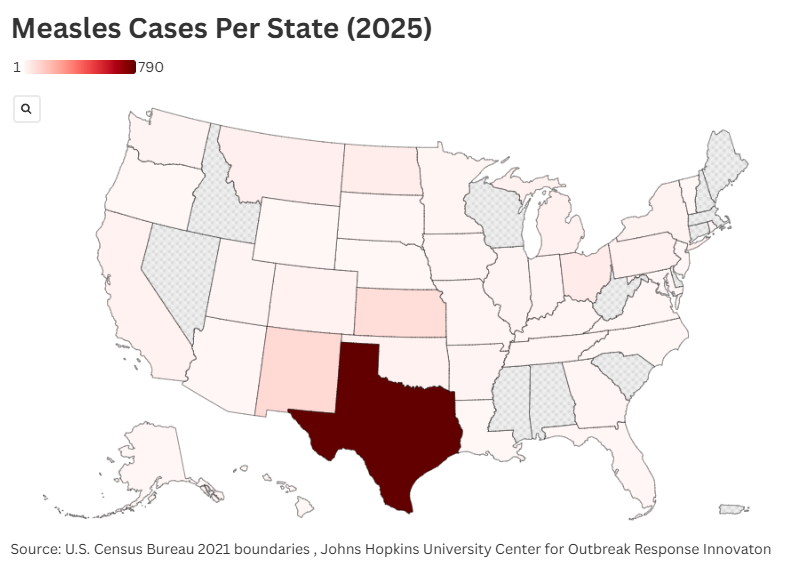The United States has already seen more measles cases in 2025 than in any year since the virus was declared eliminated nationally in 2000, with 1,277 confirmed cases as of Saturday, according to the Johns Hopkins University Center for Outbreak Response Innovation.
Dr. Neil Maniar, director of Northeastern University’s public health program, told Newsweek that this news is “very concerning” and warned there could be future outbreaks over the coming years if trends surrounding vaccinations do not reverse.
Here is a look at which states have seen the highest number of cases this year.
Why It Matters
The 1,277 figure outpaces the 1,274 cases reported during the 2019 peak, only about halfway through the year. Measles was declared eliminated in the U.S. by 2000 due to the MMR (measles, mumps, rubella) vaccine approved in 1971. The vaccine, which is easily accessible in the country, has been touted by public health experts as a safe and effective way to mitigate the spread of the virus and prevent serious illness.
However, a recent rise in vaccine skepticism associated with the COVID-19 pandemic has left a growing number of children vulnerable to infection amid new outbreaks of the virus, which can cause serious health complications or even death.
What to Know
Most measles cases this year stem from a large outbreak originating in West Texas’ Gaines County, home to a close-knit, undervaccinated Mennonite community. There have been 155 hospitalizations across the country and three confirmed deaths so far this year.
Experts attribute the current surge to declining childhood vaccination rates, a trend that worsened after the pandemic due to increased vaccine hesitancy, though most public health officials say the vaccination remains safe despite concerns—and misinformation that has spread.
In Texas, there have been 790 cases of measles so far in 2025, according to data from Johns Hopkins. Neighboring state New Mexico places second with 95 cases, while Kansas has seen 83 confirmed measles cases this year.
Ohio has seen 35 cases this year, while North Dakota rounds out the five states with the most cases at 34 confirmed instances of the virus.
Maniar said the increased number of cases is unsurprising given the rise in anti-vaccine sentiment over recent years. There are several things that must happen to prevent future outbreaks, including improvements to the infrastructure to ensure all communities have access to vaccines, as well as efforts to educate people about and restore trust in vaccines, he said.
“Measles is one of the most infectious diseases out there. Even though we have highly effective vaccine, we see many areas across the country fall below that threshold of herd immunity, 95 percent threshold,” Maniar said. “I think one can anticipate that we’ll see this types of outbreaks.”
Dr. Michael T. Osterholm, director of the Center for Infectious Disease Research and Policy at the University of Minnesota, told Newsweek the rise in cases is an international phenomenon tied to both anti-vaccine sentiment, as well as people believing that measles is no longer a problem.
“We have a lot of work to do,” he said. “How do we message to those who refuse to vaccinate or get vaccinated? This is a real problem. We have many more questions than we have answers.”
He pointed to Canada—where there have been more than 3,500 new cases this year—as an example of how rising measles cases is a global challenge.
A Department of Health and Human Services (HHS) spokesperson told Newsweek that Secretary Robert F. Kennedy Jr. has given clear guidance that vaccines are the most effective way to prevent measles. The spokesperson noted that HHS recognizes that some individuals and communities may choose not to vaccine and that HHS remains committed to supporting everyone in avoiding hospitalization and serious complications from measles.
What Are Measles Symptoms?
Measles is a highly contagious, airborne virus that can cause “serious health complications,” particularly for children who are younger than five years old, according to the U.S. Centers for Disease Control and Prevention (CDC).
The CDC notes that a single dose of the MMR vaccine is about 93 percent effective, while two doses of the vaccine is about 97 percent effective at preventing measles. Children are advised to get the first dose between 12 and 15 months of age, and the second dose when they are between 4 and 6 years old.
What People Are Saying
U.S. Centers for Disease Control and Prevention emphasized prevention: “The best way to protect against measles is to get the measles, mumps, and rubella (MMR) vaccine. Children may get the measles, mumps, rubella, and varicella (MMRV) vaccine instead, which protects against chickenpox too.”
Dr. Neil Maniar told Newsweek: “This is a disease we had eradicated in this country. We should all take notice of the fact that we are seeing numbers we haven’t seen since the early 1990s. This is concerning, but this is solvable. We eradicated measles once, so we can do it again. But it’s going to require everyone to play a role. And it’s going to require folks to make sure they get vaccinated if they haven’t. We have very safe very effective vaccine. There’s no reason anyone should be getting measles right now.”
What Happens Next?
Public health authorities have increased vaccination campaigns and are closely monitoring outbreaks and international travel, which has contributed to transmission. The trajectory of the outbreak will depend on vaccination uptake and rapid response to new cases.
The CDC continues to issue guidance and risk assessments to inform ongoing efforts.
Read the full article here

